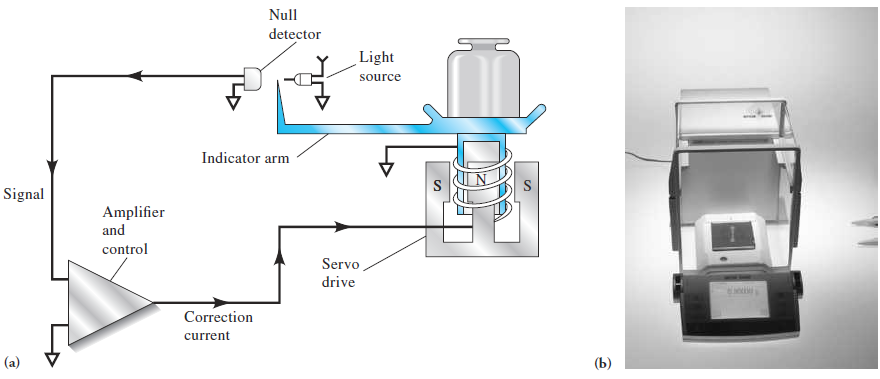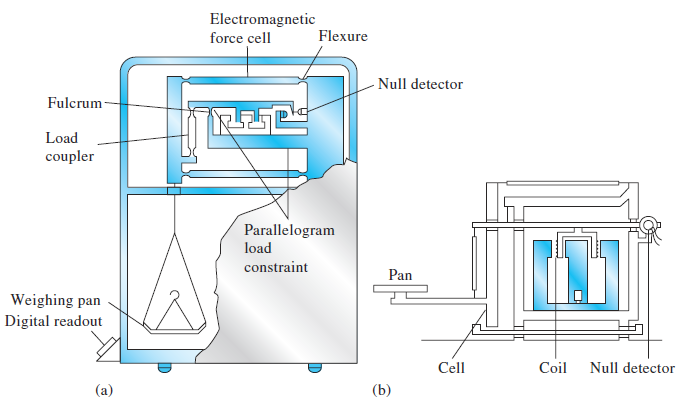


 علم الكيمياء
علم الكيمياء 
 الكيمياء التحليلية
الكيمياء التحليلية 
 الكيمياء الحياتية
الكيمياء الحياتية 
 الكيمياء العضوية
الكيمياء العضوية 
 الكيمياء الفيزيائية
الكيمياء الفيزيائية
 الكيمياء اللاعضوية
الكيمياء اللاعضوية 
 مواضيع اخرى في الكيمياء
مواضيع اخرى في الكيمياء
 الكيمياء الصناعية
الكيمياء الصناعية |
Read More
Date: 22-4-2020
Date: 5-3-2020
Date: 7-2-2020
|
The Electronic Analytical Balance
Figur1. shows a diagram and a photo of an electronic analytical balance. The pan rides above a hollow metal cylinder that is surrounded by a coil that fits over the inner pole of a cylindrical permanent magnet. An electric current in the coil produces a magnetic field that supports or levitates the cylinder, the pan and indicator arm, and whatever load is on the pan. The current is adjusted so that the level of the indicator arm is in the null position when the pan is empty. Placing an object on the pan causes the pan and indicator arm to move downward, thus increasing the amount of light striking the photocell of the null detector. The increased current from the photocell is amplified and fed into the coil, creating a larger magnetic field, which returns the pan to its original null position. A device such as this, in which a small electric current causes a mechanical system to maintain a null position, is called a servo system.

Figure1. Electronic analytical balance. (a) Block diagram. (b) Photo of electronic balance.(a) Reprinted (adapted) with permission from R. M. Schoonover, Anal. Chem., 1982, 54, 973A. Published 1982, American Chemical Society.

Figure 2. Electronic analytical balances. (a) Classical configuration with pan beneath the cell. (b) A top-loading design. Note that the mechanism is enclosed in a windowed case. (a) Reprinted (adapted) with permission from R. M. Schoonover, Anal. Chem., 1982, 54, 973A. Published 1982, American Chemical Society. (b) K.M. Lang. Amer. Lab., 1983, 15(3), 72. Copyright 1983 by International Scientific Communications, Inc.
The current required to keep the pan and object in the null position is directly proportional to the mass of the object and is easily measured, digitized, and displayed. Electronic balances are calibrated by weighing a standard mass and adjusting the current so that the exact mass of the standard appears on the display. Figure 2 shows the configurations for two electronic analytical balances. In each, the pan is tethered to a system of constraints known collectively as a cell. The cell incorporates several flexures that permit limited movement of the pan and prevent torsional forces (resulting from off-center loading) from disturbing the alignment of the balance mechanism. At null, the beam is parallel to the gravitational horizon, and each flexure pivot is in a relaxed position. Figure 2a shows an electronic balance with the pan located below the cell.
Higher precision is achieved with this arrangement than with the top-loading design shown in Figure 2b. Even so, top-loading electronic balances have a precision that equals or exceeds that of the best mechanical balances and additionally provides unencumbered access to the pan. Electronic balances generally feature an automatic taring control that causes the display to read zero with a container (such as a boat or weighing bottle) on the pan.
Most balances permit taring up to 100% of the capacity of the balance. Some electronic balances have dual capacities and dual precisions. These features permit the capacity to be decreased from that of a macrobalance to that of a semimicrobalance (30 g) with a corresponding gain in precision to 0.01 mg. These types of balances are effectively two balances in one.
A modern electronic analytical balance provides unprecedented speed and ease of use. For example, one instrument is controlled by touching a single bar at various positions along its length. One position on the bar turns the instrument on or off, another automatically calibrates the balance against a standard mass or pair of masses, and a third zeros the display, either with or without an object on the pan. Reliable mass measurements are obtainable with little or no instruction or practice.



|
|
|
|
تفوقت في الاختبار على الجميع.. فاكهة "خارقة" في عالم التغذية
|
|
|
|
|
|
|
أمين عام أوبك: النفط الخام والغاز الطبيعي "هبة من الله"
|
|
|
|
|
|
|
قسم شؤون المعارف ينظم دورة عن آليات عمل الفهارس الفنية للموسوعات والكتب لملاكاته
|
|
|